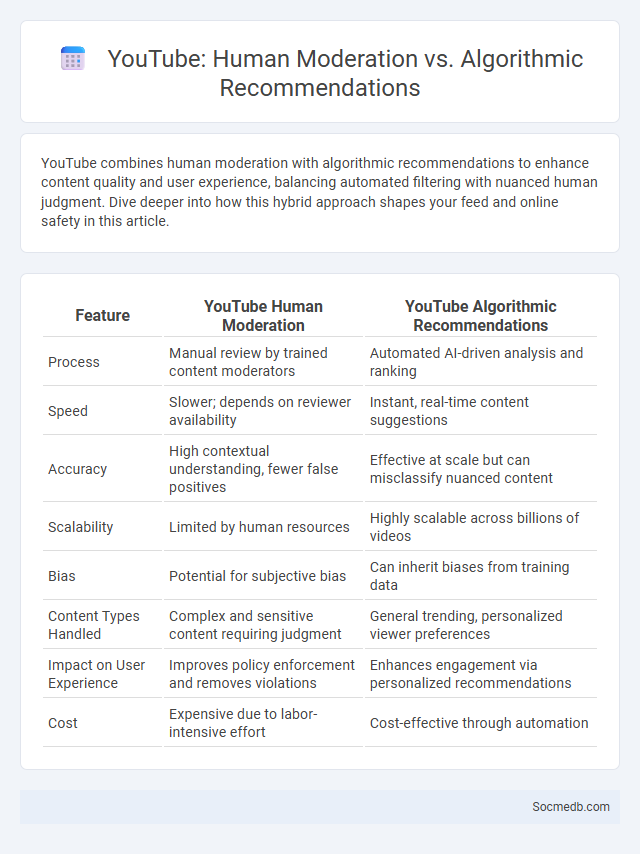
Photo illustration: YouTube Human Moderation vs Algorithmic Recommendations
YouTube combines human moderation with algorithmic recommendations to enhance content quality and user experience, balancing automated filtering with nuanced human judgment. Dive deeper into how this hybrid approach shapes your feed and online safety in this article.
Table of Comparison
| Feature | YouTube Human Moderation | YouTube Algorithmic Recommendations |
|---|---|---|
| Process | Manual review by trained content moderators | Automated AI-driven analysis and ranking |
| Speed | Slower; depends on reviewer availability | Instant, real-time content suggestions |
| Accuracy | High contextual understanding, fewer false positives | Effective at scale but can misclassify nuanced content |
| Scalability | Limited by human resources | Highly scalable across billions of videos |
| Bias | Potential for subjective bias | Can inherit biases from training data |
| Content Types Handled | Complex and sensitive content requiring judgment | General trending, personalized viewer preferences |
| Impact on User Experience | Improves policy enforcement and removes violations | Enhances engagement via personalized recommendations |
| Cost | Expensive due to labor-intensive effort | Cost-effective through automation |
Introduction: Navigating YouTube’s Recommendation Landscape
YouTube's recommendation algorithm utilizes machine learning to analyze viewer behavior, preferences, and engagement patterns, driving content discovery on the platform. By prioritizing personalized video suggestions, the system enhances user retention, influencing watching habits and content popularity. Understanding these recommendation dynamics is crucial for creators and marketers seeking to optimize visibility and audience growth on YouTube.
Understanding YouTube’s Algorithmic Recommendations
YouTube's algorithmic recommendations rely on user engagement metrics such as watch time, click-through rate, and viewer retention to personalize video suggestions. Machine learning models analyze viewing history, search queries, and interaction patterns to predict content relevance and keep users engaged longer. Prioritizing videos with higher engagement signals, the algorithm fosters content discovery while optimizing platform revenue through targeted advertising.
The Role of Human Moderation in YouTube Content
Human moderation plays a crucial role in maintaining the quality and safety of YouTube content by identifying and removing videos that violate community guidelines, such as hate speech, misinformation, and harmful material. AI algorithms assist in flagging potential violations, but human moderators provide context-sensitive judgment and nuanced understanding that machines cannot replicate. Your experience on YouTube remains safer and more enjoyable when skilled human moderators actively review flagged content to enforce policies accurately.
Strengths and Weaknesses of Algorithmic Recommendations
Algorithmic recommendations on social media enhance user experience by personalizing content, increasing engagement, and driving efficient content discovery based on individual preferences. However, these algorithms can create echo chambers by reinforcing existing beliefs and limit exposure to diverse perspectives, while also raising concerns about data privacy and potential manipulation. Continuous refinement and transparency in algorithm design are crucial to balance personalized content delivery with ethical considerations and user well-being.
Advantages and Limitations of Human Moderation
Human moderation on social media platforms ensures nuanced understanding of context, cultural sensitivity, and the ability to identify subtle violations of community guidelines that automated systems might miss. Your content benefits from accurate enforcement of policies, reducing harmful or inappropriate material through thoughtful review. However, human moderation faces limitations such as scalability challenges, potential bias, and slower response times compared to AI-driven solutions.
User Experience: Algorithms vs. Human Curated Content
Social media platforms use algorithms to personalize your feed by analyzing your interactions, preferences, and behavior, aiming to maximize engagement and relevance. Human curated content offers a more thoughtful and diverse experience, providing context and quality control that algorithms may miss. Balancing algorithmic recommendations with expertly selected content enhances user experience by combining personalization with authenticity and depth.
Addressing Misinformation and Harmful Content
Social media platforms implement advanced algorithms and content moderation policies to identify and remove misinformation and harmful content swiftly, safeguarding online communities. By fostering collaboration with fact-checking organizations and promoting digital literacy, these platforms enhance the accuracy of shared information and protect users from deceptive or dangerous material. You can contribute by reporting suspicious content and staying informed through reliable sources to maintain a safe online environment.
Scalability and Efficiency: Machines vs. Humans
Social media platforms rely on scalable algorithms and machine learning to handle billions of user interactions efficiently, outperforming human capabilities in data processing speed and pattern recognition. Machines analyze vast datasets in real time, enabling personalized content delivery and automated moderation that would be impossible for humans to achieve at scale. Your social media experience benefits from this technological efficiency, ensuring quick responses and tailored engagement across diverse networks.
The Future of YouTube Moderation and Recommendation Systems
YouTube's future moderation efforts will increasingly rely on advanced AI algorithms to detect and remove harmful content swiftly, enhancing user safety while maintaining free expression. Recommendation systems will leverage machine learning models focused on personalized content delivery to boost user engagement and reduce misinformation exposure. Continuous improvement in natural language processing and image recognition technologies will be critical to accurately understand context and nuance in videos and comments.
Conclusion: Striking the Right Balance for Optimal Recommendations
Striking the right balance in social media usage enhances your digital well-being and maximizes the quality of recommendations you receive. Tailoring your interactions and content preferences allows algorithms to better understand your interests, providing more relevant and engaging suggestions. Maintaining mindful engagement prevents algorithmic overload, ensuring that social media remains a positive and valuable resource.
 socmedb.com
socmedb.com